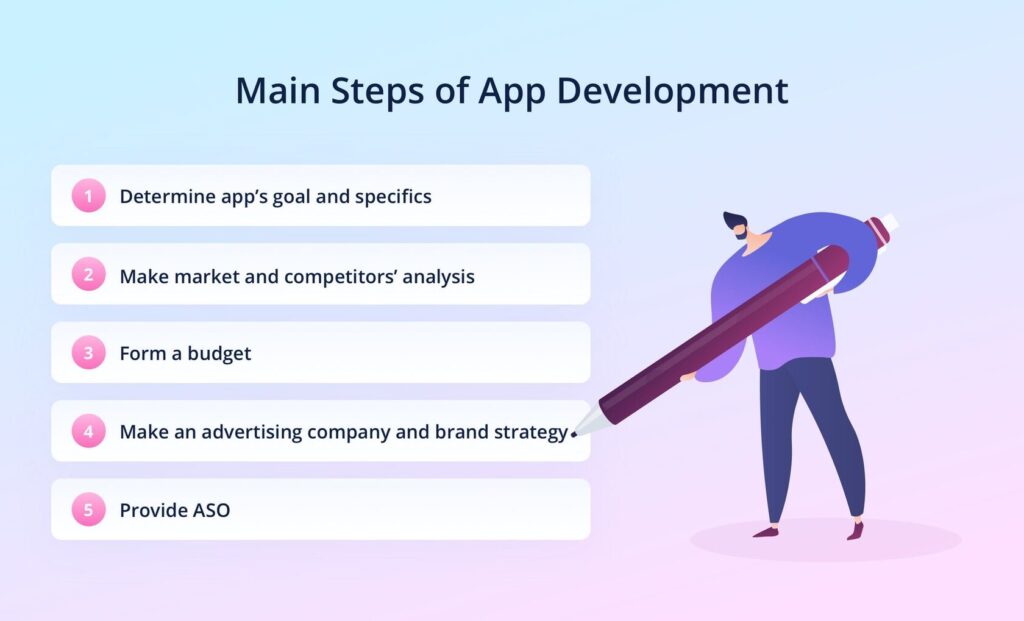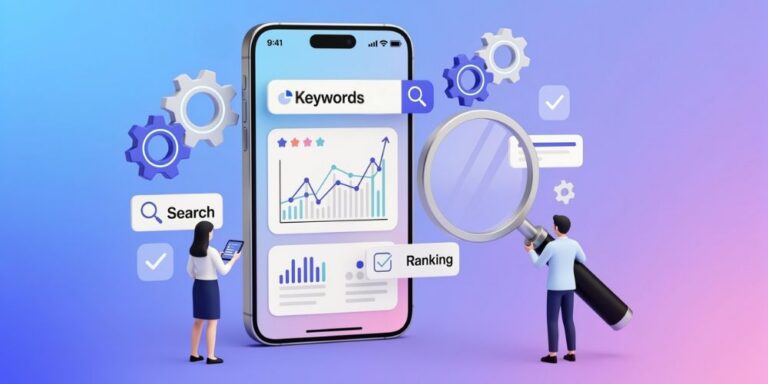A great concept is not enough to create an app that will be popular among users and bring you real income. According to statistics, a good idea is only 20% of success. To this, you should add a deep analysis of the market, knowledge of the target group’s needs and problems, skillful use of effective ASO techniques, a well-thought-out advertising campaign, and much more. A clear and step-by-step guide on how to plan an app is what can make your fantastic idea really work.
Mobile game app development has a high potential for making money. You should consider all aspects to use this opportunity to the maximum. From this article, you will learn more about which steps your plan should include, which things to consider when developing an app and promoting it, which critical mistakes to avoid, and how to best use modern marketing tools. Keep in mind that each project is unique, and the detailed list of stages might vary depending on the app specifics, the target audience, and the overall market situation. However, the basic elements of planning might be common to all.
Table of Contents
How To Plan An App: Where to Start?
The first thing you should start with when planning a mobile app is defining the purpose of your product. To do it, try to answer the question of how exactly your app will help customers and what main task it should perform. It is believed that the “goal” should be short and fit into one brief sentence.
Take Candy Crush’s example, whose developers have set themselves the task of “entertaining” their users. While it is a fairly general idea, keeping this concept in mind will help you stay on track for the whole project.
Determine the Specifics of Your App
Now that you know the product’s main goal, you can move on to the next step of your business plan for the mobile app concept, which is thinking about the technical details and choosing a platform.
Identify key technical aspects
App features, functionality, design, and other details are essential parts of the tech specifications that the development team will adhere to.
Usually, this item of the app development plan includes writing user stories (description of user behavior), a customer journey map, a detailed description of the app’s technical capabilities, a list of requirements for the interface, performance, security, notifications, and so on. That is, you should establish what your app will be, which user problems it will solve, and how exactly it will do it.
Choose the best platform for ASO strategy development
Developing a native or universal app has its pros and cons. You have to understand which mobile platform will reveal your app’s full potential. We are not talking about app stores’ specific pros and cons but rather about their capabilities and user group features.
When choosing a marketplace, you should familiarize yourself with the App Store fee, as well as their guidelines and requirements.
Android
Android is a more open platform than iOS. Unfortunately, sometimes more freedom leads to some security issues. To meet this app store’s requirements, check out our article “How to Publish an App on Google Play.”
Devices based on this operating system make up the majority (over 80%) of the mobile gadget market, giving you access to a wide Android target audience. At the same time, a huge range of Android devices, versions, and models somewhat complicates the ASO strategy development process.
Market research & competitor analysis
A detailed study of the target market, the local consumers’ needs, and the competitive environment are essential steps in making an app. Since you build a product for users, you need to understand how it can improve their lives. Find out what your target group is interested in, people’s needs, communication channels they prefer to use, and so on.
You’ll be competing with other publishers and developers for customer attention, so find out what apps they offer, their strengths and weaknesses, how they describe themselves, and more. Approach mobile apps market analysis with the utmost care. With this information, you can evaluate your product’s potential and understand which parts require more careful preparation.
Estimate the Cost of Developing Application
When planning an application, it is worth remembering that any work costs money. You need to understand right away how much budget you are ready to allocate for the tasks. Many factors affect the final App Store cost of a product. Among them are the following:
- Operating system. The number of Apple devices is limited, which simplifies the development of apps for them. The Android OS is used by many manufacturers, making it tricky to create a uniformly good mobile app user experience.
- Functionality. The more features and tools, the more pricey the app. Integrations with third-party services, GPS functions, contactless payment, chatbot, and more make a project plan for app development more expensive. Building an MVP with minimal features will help you figure out what’s really important.
- Force majeure. It is something that is difficult to foresee, but it is the reason to have an emergency fund. Any delays and complications due to inexperienced devs, sudden changes in terms of reference, outdated development tools, etc., can increase costs.
At the planning stage, you need to analyze your idea for future expenses. Based on an accurate estimate, you will be able to create a realistic budget.
Plan to Promote Your Mobile App
How to plan an app development to be effective? We recommend developing a description of your promotion activities. It is essential that you take into account the mobile app target audience characteristics and, depending on the market, use suitable advertising tools.
The better you assess the situation, the more potential users you can reach. A good promotion plan positively affects brand awareness and boosts your income.

Brand strategy
The branding strategy is just one of many steps in developing an app. However, when building it, it is worth remembering that product advertising does not end with its launch. That is, you have to continue to work on promoting the project, make efforts to expand the client base, and possibly, enter new markets.
Your brand strategy should be designed for the long term. Think about how to communicate with customers about the app’s intangible qualities and your mission or position in the world. That is, form the “identity” of your brand. It will help you connect with users on an emotional level and maintain it throughout the life cycle.
ASO strategy
If the previous point is about managing the target group, App Store Optimization is about managing app stores’ algorithms. It is carried out through the competent creation of metadata, that is, the elements of your app page, taking into account complex application analytics.
You need to build text listings and graphic assets that can increase the app’s visibility and discoverability, boosting your rankings and making the page attractive to users. Relevant keywords should be added to those text listings with the most weight, and the icon, screenshots, and video should be made catchy and unique.
For the best results, be sure to do split testing. You need to take into account not only the target audience’s characteristics but also the digital stores’ requirements.
Content creation
You might keep asking yourself, “What do I need to make an app popular?” For that, you need engaging content for sure. You have analyzed the target audience, which means you know their needs.
Create videos and post them on streaming services if your users like this format. Write or commission articles about what a great app you’ve made. Generate professional press kits that can be posted on forums and blogs. Indeed, your potential users have favorite influencers and creators with whom you can arrange a fantastic collaboration.
The purpose of such materials is to expand your presence on the Internet and, accordingly, increase brand awareness. It stirs up the interest of customers, and they come to your app page already engaged with your product.
Communication channels
The choice of communication channels that are most in demand in the target group is another step toward understanding how to start building an app. Find out which messengers, social networks, and services people use most often and create accounts in each of them.
This point is partially related to the previous one because modern platforms allow both creating new content and communicating directly with consumers. The choice of specific tools depends not only on the audience but also on the features of your product.
TikTok and Instagram are more commonly used for entertainment content, but if you tend to stick to more business/formal communication, opt for Facebook, WhatsApp Business, and emails. You should not be limited to a single channel; it is essential to offer several options so that users choose the one that is most convenient for them.
Perfect App Development Plan for Your Success
You probably understand that without clear planning, any business runs the risk of becoming unprofitable. Building mobile apps needs it no less, especially since many different factors need to be taken into account. Here is how to plan an application development in basic steps:
- Define your product’s purpose as briefly as possible.
- Pay attention to the technical side: choose the platform, describe technical features, and plan the design.
- Conduct a deep market analysis to understand competitors and target audiences.
- Form a budget, considering possible emergencies and unforeseen situations.
- Think over an advertising strategy: form a brand identity, select communication channels, and content placement, and build an ASO plan for promotion in app stores.
All this will help you create an app that will benefit your users. In an ever-increasing competition, avoid creating meaningless products that don’t solve people’s problems. Also, there is no need to try to cram many tools from different areas into one app. It is better to offer customers a few really worthwhile features at the start. Knowing the market and the target group’s wishes, as well as mastering mobile game marketing strategy and ASO technologies, is the way to success.




